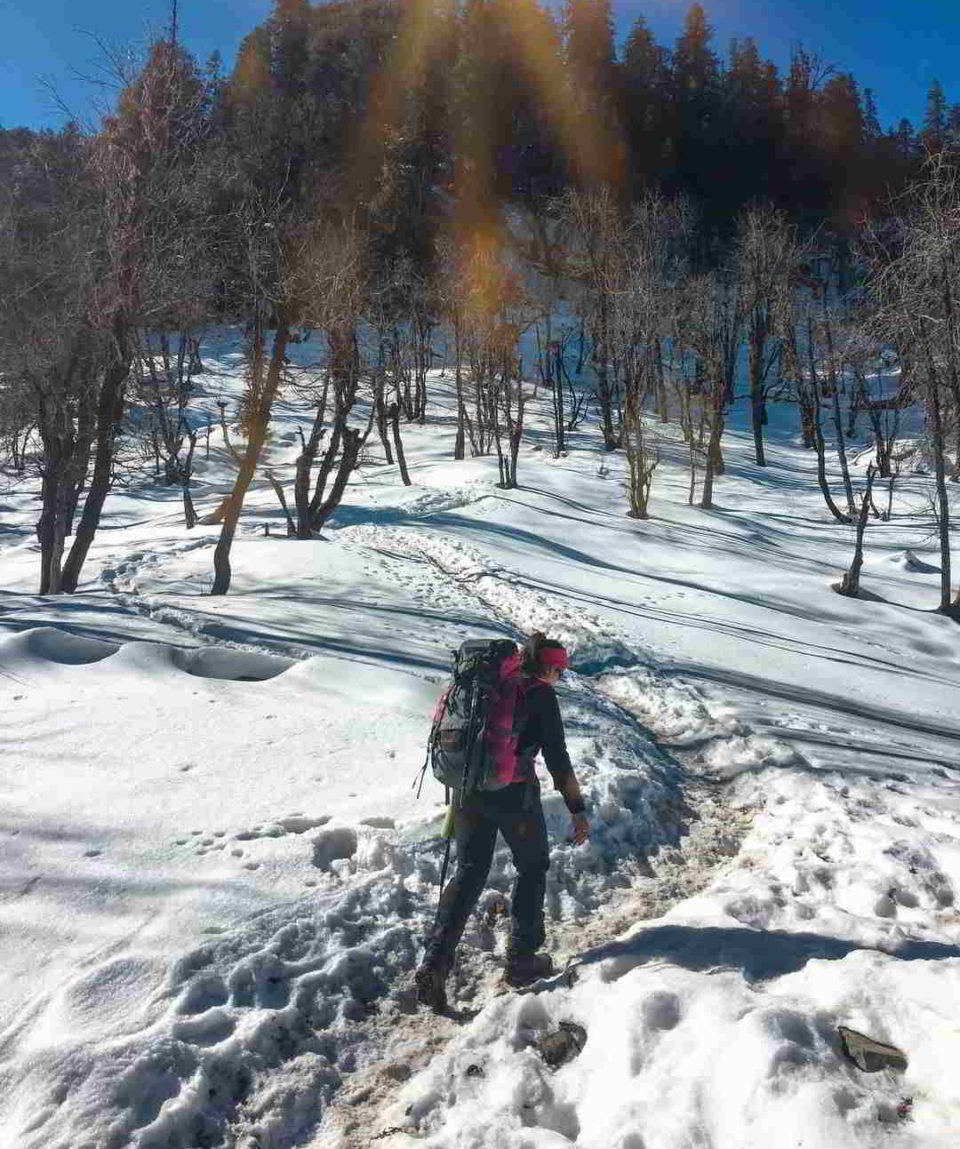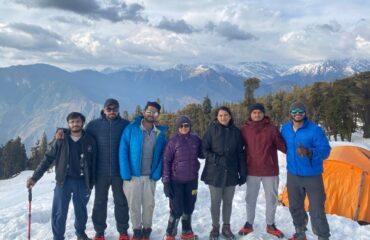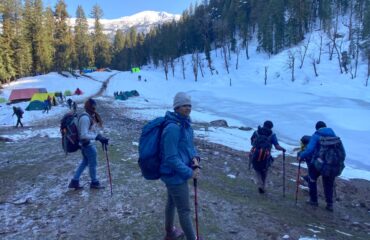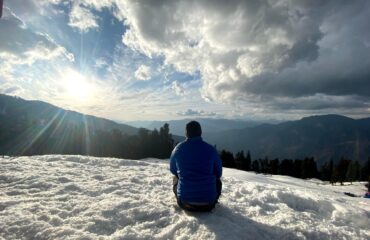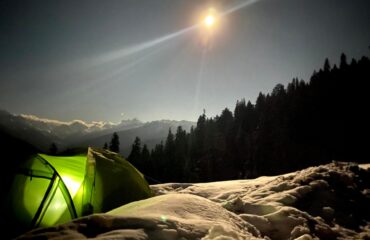Kedarkantha Trek
fromBest time to visit Kedarkantha Trek is in Winter during December to March, although the trek is accessible throughout the year except during monsoons.
-
Reviews 0 Reviews0/5
-
Vacation Style Holiday Type
-
Activity Level Fairly Easy
-
The Kedarkantha trek route starts from a charming little village called Sankri, which is a trekker’s delight as it is the doorway to many Himalayan treks. En route is the Juda-ka-Talab just 4 kms away, a glacial lake surrounded by pine trees. During Winter, the lake is frozen and the pine trees become triangular standing blocks of ice. The peace and serenity around this place takes you to a different world altogether.
Best time to do the Kedarkantha Trek
The Kedarkantha winter trek is one of the best winter treks in India. Naturally, the best time to visit Kedarkantha is in Winter during November to March, although the trek is accessible throughout the year except during monsoons. The months of December-January-February are the coldest and there will already be thick snow on the ground. Chances of experiencing fresh snowfall are also high. The stretching blanket of snow creates a quiet heavenly atmosphere as if the hills are sleeping. The snow makes for an adventurous and challenging climb to the peak. Days are gently cold and nights are harsh with freezing subzero temperatures.
- Transportation on Day 1 – Dehradun to Sankri and Day 6 Sankri to Dehradun
- Accommodation in Sankri (1st nights and 5th Night) and camp tents on twin or triple sharing basis ( Day 2 to Day 4)
- Meals on trek: Breakfast, lunch, Evening beverages (hot), snacks, soup and dinner
- Experienced and qualified professional trek guide and support staff
- All camping gear Like –
- High quality tents
- Sleeping bags
- Mattress
- Liner
- Pillow
- Separate Toilet tents – Ladies and Gents
- Dining Tent
- Dining table
- Helper
- Kitchen team
- First aid medical kits
- Oxygen Cylinders
- Gaiters or Crampons
- All permits and entrance fees
- Breakfast and lunch on the first day
- Lunch and dinner on the last day
- Personal insurance
- Individual toiletries and medicine kits
- Porters or mules for carrying personal luggage
- Any expenses borne by trekker on their own
- Train or Flight tickets charges
- 5 % GST
- Anything not mentioned in Inclusions
- Day 1 Dehradun - Sankri (200 Kms / 8 Hrs)
- Day 2 Sankri - Juda-ka-Talab (5 Kms / 4 Hrs)
- Day 3 Juda-ka-Talab - Kedarkantha base camp (4 Kms / 3 Hrs)
- Day 4 Kedarkantha Base - Kedarkantha Summit - Hargaon or Juda Ka Talab base (9 Kms / 8 Hrs)
- Day 5 Hargaon or Juda Ka Talab - Sankri (5.5 Kms / 3 Hrs)
- Day 6 Sankri - Dehradun (200 Kms / 8 Hrs)
The best time to embark on the Kedarkantha Trek is in winter between December – April. Although the trek remains open for most of the year, the monsoon months are better avoided. Heavy rainfall makes the trek route slippery and a bit dangerous.
The highest altitude reached during the trek will be 12,500 feet which is the Kedarkantha Summit. The trek from the Kedarkantha base camp to the peak is taken on the fourth day of the trip.
The Kedarkantha Trek cost is INR 7000 to 8000 Rupees/person. The cost includes pick-up and drop to and from Dehradun, all meals starting during the 6 days of trek, permits and entry fees and accommodation. Refer to the Inclusions section for details.
The Kedarkantha Trek is broadly easy with moderate trek. It is very suitable for first-timers & beginners and can be easily completed by ensuring minimum fitness.
Kedarkantha trek is 23 kms long from Sankri and takes 4 days. It takes about two and a half days for the ascent and one and a half days for descent. A day each for travelling to and from Dehradun makes the entire trek of 6 days.
Buy only very good quality trekking shoes with excellent grip and water resistance features. Ordinary sports shoes or walking shoes will absolutely not do. We recommend good waterproof shoes.
The Kedarkantha winter trek is one of the safest treks that is accessible during the winter months. It is absolutely safe for beginners as well. You will have certified and experienced trek guides with you along with support staff. Although if you have any respiratory disorders or any other medical conditions, then its best not to attempt this trek.
The reason why many first-timers begin their affair with trekking with the Kedarkantha Trek is because it’s easy to moderate level trek. Most of the trail is easy to climb, only a couple of ascents before submitting the Kedarkantha trek are steep.
The temperature in December ranges from -5°C to 5°C. With increasing altitudes the temperature keeps dropping with chilling winds. You might also get to experience snowfall on the way which makes the journey even more magical.
Ensuring an optimum fitness level is must for this trek. People with respiratory problems and asthma are not allowed. Don’t overtrain just before the trek. Do some daily basis yoga, morning walk and exercise.
Absolutely not! Intaking alcohol during the whole journey is strictly prohibited since it can cause nausea and vomiting.
Mostly vegetarian meals that include breakfast, lunch, and dinner, soup, and hot beverages in the morning and evening with light snacks are provided. Refer the Inclusion section for more details.
No, Kedarnath and Kedarkantha are not the same. In fact they are separated by a distance of a hundred kms. Kedarnath is one of the four Char Dham and also one of the 12 Jyotirlinga sites in India known for the Kedareswar temple. Kedarkantha is a mountain peak in Uttarakhand of the Garhwal Himalayan range.
The Kedarkantha winter trek is known for its layers and layers of snow on the ground, tree-tops, and the mountain peaks. You will definitely find snow, may even experience fresh snowfall if you’re travelling between December to February.
No, there will be no mobile network during the trek. The last point of mobile network is Purola, Uttarakhand

